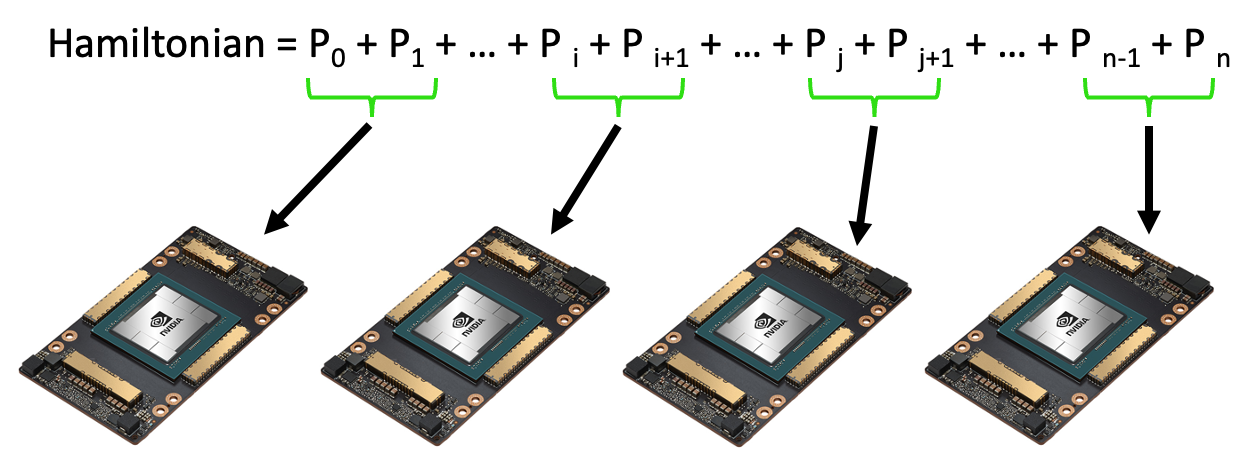Multi-GPU Workflows¶
There are many backends available with CUDA Quantum which enable seamless switching between GPUs, QPUs and CPUs and also allow for workflows involing multiple architectures working in tandem.
[1]:
import cudaq
targets = cudaq.get_targets()
# for target in targets:
# print(target)
Available Targets¶
qpp-cpu: The qpp based CPU backend which is multithreaded to maximize the usage of available cores on your system.
nvidia: GPU based backend which accelerates quantum circuit simulation on NVIDIA GPUs powered by cuQuantum.
nvidia-mqpu: Enables users to program workflows utilizing multiple quantum processors enabled today by GPU emulation.
nvidia-mgpu: Allows for scaling circuit simulation beyond what is feasible with any QPU today.
density-matrix-cpu: Noisy simulations via density matrix calculations. CPU only for now with GPU support coming soon.
Below we explore how to effectively utilize multi-GPU targets.
[2]:
def ghz_state(qubit_count, target):
"""A function that will generate a variable sized GHZ state (`qubit_count`)."""
cudaq.set_target(target)
kernel = cudaq.make_kernel()
qubits = kernel.qalloc(qubit_count)
kernel.h(qubits[0])
for i in range(1, qubit_count):
kernel.cx(qubits[0], qubits[i])
kernel.mz(qubits)
result = cudaq.sample(kernel, shots_count=1000)
return result
QPP-based CPU Backend¶
[3]:
cpu_result = ghz_state(qubit_count=2, target="qpp-cpu")
cpu_result.dump()
{ 00:518 11:482 }
Acceleration via NVIDIA GPUs¶
Users will notice a 200x speedup in executing the circuit below on NVIDIA GPUs vs CPUs.
[4]:
gpu_result = ghz_state(qubit_count=25, target="nvidia")
gpu_result.dump()
{ 0000000000000000000000000:477 1111111111111111111111111:523 }
Multiple NVIDIA GPUs¶
A \(n\) qubit quantum state has \(2^n\) complex amplitudes, each of which require 8 bytes of memory to store. Hence the total memory required to store a \(n\) qubit quantum state is \(8\) bytes \(\times 2^n\). For \(n = 30\) qubits, this is roughly \(8\) GB but for \(n = 40\), this exponentially increases to 8700 GB.
If one incrementally increases the qubit count in their circuit, we reach a limit where the memory required is beyond the capabilities of a single GPU. The nvidia-mgpu target allows for memory from additional GPUs to be pooled enabling qubit counts to be scaled.
Execution on the nvidia-mgpu backed is enabled via mpirun. Users need to create a .py file with their code and run the command below in terminal:
mpirun -np 4 python3 test.py
where 4 is the number of GPUs one has access to and test is the file name chosen.
Multiple QPU’s¶
The nvidia-mqpu backend allows for future workflows made possible via GPU simulation today.
Expectation value computations of multi-term hamiltonians can be asynchronously processed via the mqpu platform.

[5]:
cudaq.set_target("nvidia-mqpu")
qubit_count = 15
term_count = 100000
kernel = cudaq.make_kernel()
qubits = kernel.qalloc(qubit_count)
kernel.h(qubits[0])
for i in range(1, qubit_count):
kernel.cx(qubits[0], qubits[i])
# We create a random hamiltonian with 10e5 terms
hamiltonian = cudaq.SpinOperator.random(qubit_count, term_count)
# The observe calls allows us to calculate the expectation value of the Hamiltonian, batches the terms, and distributes them over the multiple QPU's/GPUs.
# expectation = cudaq.observe(kernel, hamiltonian) # Single node, single GPU.
expectation = cudaq.observe(
kernel, hamiltonian,
execution=cudaq.parallel.thread) # Single node, multi-GPU.
# expectation = cudaq.observe(kernel, hamiltonian, execution= cudaq.parallel.mpi) # Multi-node, multi-GPU.
Asynchronous data collection via circuit batching
Execution of parameterized circuits with different parameters can be executed asynchronously via the mqpu platform.

[6]:
import cudaq
from cudaq import spin
import numpy as np
np.random.seed(1)
cudaq.set_target("nvidia-mqpu")
qubit_count = 5
sample_count = 10000
h = spin.z(0)
parameter_count = qubit_count
# Below we run a circuit for 10000 different input parameters.
parameters = np.random.default_rng(13).uniform(low=0,
high=1,
size=(sample_count,
parameter_count))
kernel, params = cudaq.make_kernel(list)
qubits = kernel.qalloc(qubit_count)
qubits_list = list(range(qubit_count))
for i in range(qubit_count):
kernel.rx(params[i], qubits[i])
[7]:
%timeit result = cudaq.observe(kernel, h, parameters) # Single GPU result.
29.7 s ± 548 ms per loop (mean ± std. dev. of 7 runs, 1 loop each)
[8]:
print('We have', parameters.shape[0],
'parameters which we would like to execute')
xi = np.split(
parameters,
4) # We split our parameters into 4 arrays since we have 4 GPUs available.
print('We split this into', len(xi), 'batches of', xi[0].shape[0], ',',
xi[1].shape[0], ',', xi[2].shape[0], ',', xi[3].shape[0])
We have 10000 parameters which we would like to execute
We split this into 4 batches of 2500 , 2500 , 2500 , 2500
[9]:
%%timeit
# Timing the execution on a single GPU vs 4 GPUs, users will see a 4x performance improvement
asyncresults = []
for i in range(len(xi)):
for j in range(xi[i].shape[0]):
asyncresults.append(
cudaq.observe_async(kernel, h, xi[i][j, :], qpu_id=i))
939 ms ± 3.37 ms per loop (mean ± std. dev. of 7 runs, 1 loop each)